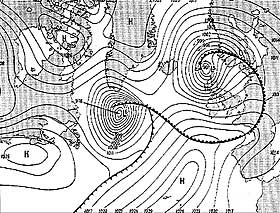
Sverre Petterssen
Encyclopedia
Sverre Petterssen was a Norwegian
meteorologist, prominent in the field of weather analysis and forecasting, and an international leader in meteorology.
into a humble family, he paid for his higher education by working at the telegraph office, and a nursery provided by the armed forces that he joined as a recruit. He studied in Bergen where he met Tor Bergeron
during a lecture, and was so impressed by his analysis of a 1922 storm that he joined the Bergen School of Meteorology
in 1923.
With the invasion of Norway, Petterssen returned to Europe
and offered his services in England
to the Met Office
, on loan from the Norwegian Air Force. During World War II
, he served as a weather forecaster for bombing raids and special operations.
He is most remembered for his work in what has been called the most significant weather forecast in history, the D-Day
Forecast, where he contributed significantly to the postponement of D-day by one day. Three groups of meteorologists gave advice to General Dwight Eisenhower, and D-Day
was originally planned for June 5, 1944. The forecast provided by Sverre Petterssen and the other meteorologists caused Eisenhower to decide at 0430 on 4 June to postpone D-day to June 6. Initially it was proposed to postpone the operation to June 19, but fortunately all three teams predicted a break in the weather on June 6.
 On June 19 the worst storm to date in the century struck the English channel
On June 19 the worst storm to date in the century struck the English channel
. If D-Day had been launched on June 5 as originally planned, the Allied casualties would probably have been much higher, and even higher if launched on June 19. On June 17 all the teams predicted perfect weather conditions for June 19, but D-day was over.
Norway
Norway , officially the Kingdom of Norway, is a Nordic unitary constitutional monarchy whose territory comprises the western portion of the Scandinavian Peninsula, Jan Mayen, and the Arctic archipelago of Svalbard and Bouvet Island. Norway has a total area of and a population of about 4.9 million...
meteorologist, prominent in the field of weather analysis and forecasting, and an international leader in meteorology.
Early life
Born in NorwayNorway
Norway , officially the Kingdom of Norway, is a Nordic unitary constitutional monarchy whose territory comprises the western portion of the Scandinavian Peninsula, Jan Mayen, and the Arctic archipelago of Svalbard and Bouvet Island. Norway has a total area of and a population of about 4.9 million...
into a humble family, he paid for his higher education by working at the telegraph office, and a nursery provided by the armed forces that he joined as a recruit. He studied in Bergen where he met Tor Bergeron
Tor Bergeron
Tor Bergeron was the Swedish meteorologist who proposed a mechanism for the formation of precipitation in clouds. In the 1930s, Bergeron and W. Findeisen developed the concept that clouds contain both supercooled water and ice crystals...
during a lecture, and was so impressed by his analysis of a 1922 storm that he joined the Bergen School of Meteorology
Bergen School of Meteorology
The "Bergen School of Meteorology" is a school of thought which is the basis for much of modern weather forecasting.Founded by the meteorologist Prof...
in 1923.
Career
After school, he remained a weather officer in the Norwegian Air Force until 1939. He went to the US in 1935, lecturing on Norwegian meteorological theories to the US Navy and Caltech. In 1939, he was hired by MIT as head of the meteorology department, and wrote two important books there: Weather analysis and forecasting (1940) and Introduction to Meteorology (1941).With the invasion of Norway, Petterssen returned to Europe
Europe
Europe is, by convention, one of the world's seven continents. Comprising the westernmost peninsula of Eurasia, Europe is generally 'divided' from Asia to its east by the watershed divides of the Ural and Caucasus Mountains, the Ural River, the Caspian and Black Seas, and the waterways connecting...
and offered his services in England
England
England is a country that is part of the United Kingdom. It shares land borders with Scotland to the north and Wales to the west; the Irish Sea is to the north west, the Celtic Sea to the south west, with the North Sea to the east and the English Channel to the south separating it from continental...
to the Met Office
Met Office
The Met Office , is the United Kingdom's national weather service, and a trading fund of the Department for Business, Innovation and Skills...
, on loan from the Norwegian Air Force. During World War II
World War II
World War II, or the Second World War , was a global conflict lasting from 1939 to 1945, involving most of the world's nations—including all of the great powers—eventually forming two opposing military alliances: the Allies and the Axis...
, he served as a weather forecaster for bombing raids and special operations.
He is most remembered for his work in what has been called the most significant weather forecast in history, the D-Day
D-Day
D-Day is a term often used in military parlance to denote the day on which a combat attack or operation is to be initiated. "D-Day" often represents a variable, designating the day upon which some significant event will occur or has occurred; see Military designation of days and hours for similar...
Forecast, where he contributed significantly to the postponement of D-day by one day. Three groups of meteorologists gave advice to General Dwight Eisenhower, and D-Day
D-Day
D-Day is a term often used in military parlance to denote the day on which a combat attack or operation is to be initiated. "D-Day" often represents a variable, designating the day upon which some significant event will occur or has occurred; see Military designation of days and hours for similar...
was originally planned for June 5, 1944. The forecast provided by Sverre Petterssen and the other meteorologists caused Eisenhower to decide at 0430 on 4 June to postpone D-day to June 6. Initially it was proposed to postpone the operation to June 19, but fortunately all three teams predicted a break in the weather on June 6.

English Channel
The English Channel , often referred to simply as the Channel, is an arm of the Atlantic Ocean that separates southern England from northern France, and joins the North Sea to the Atlantic. It is about long and varies in width from at its widest to in the Strait of Dover...
. If D-Day had been launched on June 5 as originally planned, the Allied casualties would probably have been much higher, and even higher if launched on June 19. On June 17 all the teams predicted perfect weather conditions for June 19, but D-day was over.
See also
- Bergen School of MeteorologyBergen School of MeteorologyThe "Bergen School of Meteorology" is a school of thought which is the basis for much of modern weather forecasting.Founded by the meteorologist Prof...
- Surface weather analysisSurface weather analysisSurface weather analysis is a special type of weather map that provides a view of weather elements over a geographical area at a specified time based on information from ground-based weather stations...
- Donald Norton YatesDonald Norton YatesDonald Norton Yates was the US Army Air Force officer who helped select June 6, 1944 as the date for D-Day, the Allied invasion of Europe, in his capacity as chief meteorologist on General Dwight D. Eisenhower's staff...

